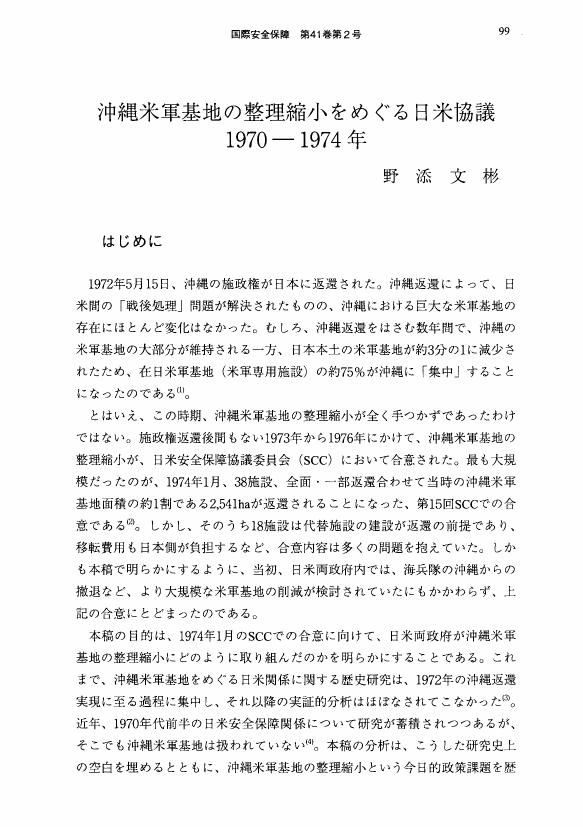3 0 0 0 OA 戦後沖縄の東アジア国際秩序認識 - 歴史的概観
- 著者
- 野添 文彬
- 雑誌
- 沖縄法学 = Journal of the Association of Law, the Okinawa International University (ISSN:02870649)
- 巻号頁・発行日
- no.48, pp.1-22, 2020-03
日本学術振興会科学研究費若手研究「沖縄への米軍基地集中に関する外交史-三つの局面の分析(研究課題番号18K12737)」の研究成果である
- 著者
- 野添 文彬
- 出版者
- 沖縄国際大学法学会
- 雑誌
- 沖縄法学 (ISSN:02870649)
- 巻号頁・発行日
- no.49, pp.107-142, 2021-03
1 0 0 0 OA 川名 晋史 著『基地の消長 1968-1973年 ――日本本土の米軍基地「撤退」政策』
- 著者
- 野添 文彬
- 出版者
- 国際安全保障学会
- 雑誌
- 国際安全保障 (ISSN:13467573)
- 巻号頁・発行日
- vol.48, no.4, pp.101-105, 2021-03-31 (Released:2022-04-01)
1 0 0 0 OA 沖縄米軍基地の整理縮小をめぐる日米協議1970-1974年
- 著者
- 野添 文彬
- 出版者
- 国際安全保障学会
- 雑誌
- 国際安全保障 (ISSN:13467573)
- 巻号頁・発行日
- vol.41, no.2, pp.99-115, 2013-09-30 (Released:2022-04-07)
- 著者
- 野添 文彬
- 出版者
- 沖縄国際大学法学会
- 雑誌
- 沖縄法学 (ISSN:02870649)
- 巻号頁・発行日
- no.49, pp.107-142, 2021-03
日本学術振興会科学研究費若手研究「沖縄への米軍基地集中に関する外交史-三つの局面の分析(研究課題番号18K12737)」の研究成果である
- 著者
- 野添 文彬
- 出版者
- 大阪歴史科学協議会
- 雑誌
- 歴史科学 (ISSN:09105662)
- 巻号頁・発行日
- no.233, pp.18-28, 2018-05
1 0 0 0 OA 米国の東アジア戦略と沖縄返還交渉
- 著者
- 野添 文彬
- 出版者
- 一般財団法人 日本国際政治学会
- 雑誌
- 国際政治 (ISSN:04542215)
- 巻号頁・発行日
- vol.2013, no.172, pp.172_1-172_14, 2013-02-25 (Released:2015-03-05)
- 参考文献数
- 79
This article aims to examine the US-Japan negotiation process over the reversion of Okinawa in the context of US strategy in East Asia. In November, 1969, Japanese Prime Minister Sato Eisaku and US President Richard M. Nixon reached an agreement on the reversion of Okinawa. This was a highly significant agreement because it settled a war-related issue between Japan and the United States, and thus contributed to the stabilization of the US-Japan alliance. The existing literature has focused on the US-Japan bilateral negotiation process and has tended to emphasize that the US government had achieved a greater level of burden-sharing with Japan thorough the negotiations. Recently, due to the declassification of numerous documents by the Ministry of Foreign Affairs, researchers have begun to explore the policy-making process in the Government of Japan. The reversion of Okinawa was not only a US-Japan bilateral issue, but also had implications for the region due to the fact that the US bases in Okinawa have played important roles in both the defense of Japan and regional security in East Asia. Furthermore, during that period, the Nixon administration reviewed the global strategy of the United States due to various international difficulties such as the ongoing war in Vietnam, Soviet military expansion, and the rapid economic rise of Japan. Therefore, the Nixon administration sought the détente with the Soviet Union, the rapprochement with the People’s Republic of China (PRC), and the application of the Nixon Doctrine. Despite these facts suggesting the significance of paying attention to the international context, previous works have not analyzed how the process of the reversion of Okinawa was related to the US strategy in East Asia. This article reexamines the reversion of Okinawa by focusing on the US strategy in East Asia during the period from the Johnson administration to the Nixon administration, particularly the policies toward the PRC and the Republic of Korea (ROK). Analyzing documents on US policies toward PRC and ROK as well Japan, this article extends the scope of its analysis from the US-Japan bilateral relations to the international relations in East Asia. This article argues that the US government regarded the agreement of the reversion of Okinawa as an essential step toward reconstruction of her strategy in East Asia, such as the rapprochement with PRC and the reduction of the US military presence in ROK. The US government sought to readjust the US-Japan alliance by settling the reversion of Okinawa since the US placed great value on the US-Japan alliance and also wanted to prevent Japan from pursuing more independent policies such as the development of her own nuclear weapon and to promote Japan’s burden-sharing. In addition to that, the US government succeeded in maintaining her credibility toward her allies by preserving bases in Okinawa. In other words, for the US government, maintaining the US-Japan alliance and preserving bases in Okinawa was an essential prerequisite for her strategy in East Asia. Therefore, the reversion of Okinawa not only settled a war-related issue among the US and Japan, but can also be interpreted as the beginning of the transformation of the international order in East Asia initiated by the US government.

